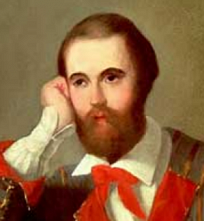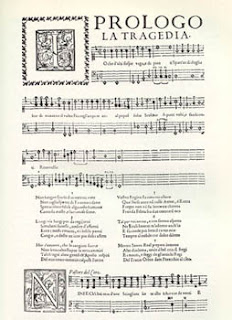16th century singer who helped create opera genre
 |
| Giulio Caccini was at the forefront of a new musical movement |
The father of the composer Francesca Caccini and the singer Settimia Caccini, he served for some years at the court of the Medici family in Florence, by whom he was also employed, as a somewhat unusual sideline, as a spy.
Caccini wrote the music for three operas and published two collections of songs and madrigals. His songs for solo voice accompanied by one musical instrument gained him particular fame and he is remembered now for one particular song, a madrigal entitled Amarilli, mia bella, which is often sung by voice students.
Caccini is thought to have been born in Tivoli, just outside Rome, the son of a carpenter, Michelangelo Caccini, from Montopoli, near Pisa. His younger brother, Giovanni, became a sculptor and architect in Florence.
He developed his voice as a boy soprano in the prestigious Cappella Giulia at St. Peter’s basilica in Rome, studying under maestro di cappella Giovanni Animuccia. Subsequently, he was invited to Florence by Prince Francesco de’ Medici to perform at his wedding to Johanna of Austria.
 |
| The title page of Caccini's collection Le Nuove Musiche, published in 1601 |
He became part of a movement of humanists, writers, musicians and scholars known as the Florentine Camerata, which was dedicated to restoring public appreciation of ancient Greek dramatic music. It was the Camerata who developed the new concept of monody—an emotionally affective solo vocal line, accompanied by relatively simple chordal harmony on one or more instruments.
Caccini became a teacher as well as a singer and composer, training dozens of musicians to sing in the new style, including the castrato Giovanni Gualberto Magli, who sang in the first production of Monteverdi's first opera Orfeo.
He also acquired a reputation as a man driven by jealousy, envy and greed. To advance his position within the Medici court, for example, he spied on behalf of Pietro de’ Medici on Pietro’s wife, Eleonora di Garzia da Toledo, and uncovered an affair, which led an enraged Pietro to murder his wife and have her lover killed.
In 1584, he married another singer, Lucia di Filippo Gagnolanti, with whom he had his two daughters, Francesca and Settimia.
 |
| Pietro de' Medici, the prince who employed Caccini to spy on his unfaithful wife |
He continued to be employed by Ferdinando until he lost his job in 1593 after a fight with one of his students. His wife, Lucia, died in the same year.
Caccini was known for his intense rivalry with fellow composers Emilio de' Cavalieri and Jacopo Peri. There are suspicions that it was Caccini who arranged for a furious Cavalieri to be removed from his post as director of festivities for the wedding of Henry IV of France and Maria de' Medici in 1600, while in response to hearing that Peri was working on a opera production of Euridice, based on the Greek myth of Orpheus and Eurydice, he hurriedly wrote his own version of the same story and ordered the singers under his charge to have nothing to do with Peri's production.
By around 1603, Caccini had established a singing group consisting of his daughters Francesca and Settimia, his illegitimate son Pompeo, and his second wife, Margherita di Agostino Benevoli della Scala. The group became very famous and, in 1604, were invited to France by Maria de' Medici. Francesca was offered a position at the French court but could not accept because of the Florentine court’s refusal to release her.
After his return to Florence, Caccini continued to write music for court celebrations, especially weddings, while trying to find husbands for his daughters.
In the last years of his life, Caccini was in trouble again in 1615 for fighting with the son of a famed singer and was placed under house arrest. Thereafter his health began to decline and he died in December 1618. He is buried in the Basilica of Santissima Annunziata in Florence.
 |
| The Arch of Castruccio and the Tower of San Matteo, in the background, are echoes of Montopoli Val d'Arno's history |
Montopoli Val D’Arno, where Caccini’s father was born, is a small town on the banks of the Arno river about 40km (25 miles) southwest of Florence and about 30km (19 miles) east of Pisa, roughly halfway between Florence and the mouth of the Arno at Marina di Pisa. It is a town largely of medieval origins, which was regular fought over by Lucca, Pisa and Florence because of its strategic position. The remains of a fortress, the best preserved of which are the Tower of San Matteo and the Arch of Castruccio are worth a visit. The area is blessed with a beautiful landscape and an economy based culture based on agriculture, arts and crafts and other traditional industries of Tuscany.
 |
| Giovanni Caccini's facade of the church of Santissima Annunziata |
The Basilica della Santissima Annunziata, where Caccini is buried, is a Renaissance-style minor basilica in Florence, located on the square of the same name, just over a kilometre’s walk north of the Piazza della Signoria. Built between 1469 and 1481 on the site of a pre-existing church by Leon Battista Alberti, it was refurbished in Baroque-style in the 17th century. The facade of the church, of semi-circular arches mounted on columns, was added in 1601 by Giulio Caccini’s brother, Giovanni, imitating the Renaissance-style of Brunelleschi's facade of the Foundling Hospital.
More reading:
Francesca Caccini and the oldest surviving opera composed by a woman
How Jacopo Peri gave the world its first opera
The Medici daughter who became the queen of France
Also on this day:
1881: The birth of Vincenzo Peruggia - the thief who stole the Mona Lisa
1957: The birth of footballer Antonio Cabrini
Home





